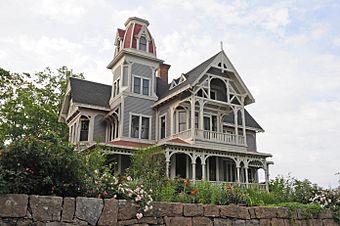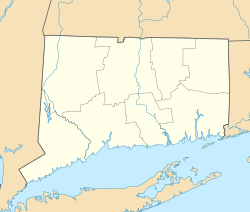Isaac C. Lewis Cottage facts for kids
|
Isaac C. Lewis Cottage
|
|
|
U.S. Historic district
Contributing property |
|

House in 2016
|
|
| Location | 255 Thimble Islands Rd., Branford, Connecticut |
|---|---|
| Area | 1 acre (0.40 ha) |
| Built | 1882 |
| Architect | Jones, Henry Martin |
| Architectural style | Gothic, Stick/Eastlake |
| Part of | Stony Creek-Thimble Islands Historic District (ID88002844) |
| NRHP reference No. | 97000811 |
Quick facts for kids Significant dates |
|
| Added to NRHP | July 25, 1997 |
| Designated CP | December 16, 1988 |
The Isaac C. Lewis Cottage is a really old and special house in Branford, Connecticut. It's located at 255 Thimble Islands Road. This house was built way back in 1882. It's a great example of a Victorian-style summer home by the sea, with lots of different design ideas mixed together.
This cottage is part of the Stony Creek–Thimble Islands Historic District. It was also added to the National Register of Historic Places in 1997, which means it's a very important historical building.
What Makes This House Special?
The Isaac C. Lewis Cottage is in a popular summer spot called the Thimble Islands area in Branford. It's a 2-1/2 story house, which means it has two main floors and a half-story, like an attic space. It shows off a mix of different building styles from the late Victorian era. These include parts of the Second Empire, Gothic Revival, and Stick Style.
Outside the House
The outside of the house uses a cool mix of materials. You can see board-and-batten siding, which are wide boards with thin strips covering the seams. There are also fish-scale wood shingles, which look like fish scales. And, of course, regular clapboards.
One of the most eye-catching parts of the house is its tower. This tower has a special type of roof called a mansard roof. It's a unique shape that makes the house stand out.
Inside the House
The inside of the Isaac C. Lewis Cottage is just as fancy as the outside. It has lots of detailed decorations. Some of the ceilings are even hand-painted, which is pretty amazing!
Who Built This House?
This historic house was built in 1882. It was meant to be a summer home by the ocean. The person who built it was Isaac C. Lewis. He was a successful businessman who made silver products in Meriden.
The house was designed by an architect named Henry Martin Jones. He was also from Meriden. Interestingly, Henry Martin Jones also designed Isaac C. Lewis's main home in the city, which was built in a different style.
Jones probably learned a lot from another famous architect, Henry Austin. Even though this house is one of Jones's more "playful" designs, you can still see some ideas that Austin used in his own buildings. The design of the cottage mixes some classic, correct architectural ideas with more common, local features, like the cool sawtooth shingling.



